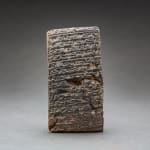Cuneiform Tablet, 2030 BCE
terracotta
1.75 x 3.75
P.535
Further images
Sumerian cuneiform is one of the earliest known forms of written expression. First appearing in the 4th millennium BC in what is now Iraq, it was dubbed cuneiform (‘wedge-shaped’) because...
Sumerian cuneiform is one of the earliest known forms of written expression. First appearing in the 4th millennium BC in what is now Iraq, it was dubbed cuneiform (‘wedge-shaped’) because of the distinctive wedge form of the letters, created by pressing a reed stylus into wet clay. Early Sumerian writings were essentially pictograms, which became simplified in the early and mid 3rd millennium BC to a series of strokes, along with a commensurate reduction in the number of discrete signs used (from c.1500 to 600). The script system had a very long life, and was used by the Sumerians as well as numerous later groups – notably the Assyrians, Elamites, Akkadians and Hittites – for around three thousand years. Certain signs and phonetic standards live on in modern languages of the Middle and Far East, but the writing system is essentially extinct. It was therefore cause for great excitement when the ‘code’ of ancient cuneiform was cracked by a group of English, French and German Assyriologists and philologists in the mid 19th century AD. This opened up a vital source of information about these ancient groups that could not have been obtained in any other way. Cuneiform was used on monuments dedicated to heroic – and usually royal – individuals, but perhaps it’s most important function was that of record keeping. The palace-based society at Ur and other large urban centres was accompanied by a remarkably complex and multifaceted bureaucracy, which was run by professional administrators and a priestly class, all of whom were answerable to central court control. Most of what we know about the way the culture was run and administered comes from cuneiform tablets, which record the everyday running of the temple and palace complexes in minute detail, as in the present case. The Barakat Gallery has secured the services of Professor Lambert (University of Birmingham), a renowned expert in decipherment and translation of cuneiform, to examine and process the information on these tablets. His analysis is presented below. Clay Tablet (95 x 49 mm) with Sumerian Cuneiform Inscriptio The tablet has a total of 33 lines and is joined from two pieces with a little loss on the reverse, and less on the obverse. Most is well preserved. The text is an administrative document from the period of the third dynasty of Ur, dated to the ninth year of Shu-Sin, fourth king of the dynasty, c. 2029 BC. It details the pay of female weavers.
Translation:
80 sila of barley, 3 minas of wool: Beli-dumqi, mother of Ahu’ 82 minas: Gashub, daughter of Ahu’a, who was crushing flax-see Both from the town Sariq, from Ennugula of E-Sagadena of Nippu Via Puzur-Ashgi, son of Beli-dan, the heral Month: Nig-Enlill 93 (minas): Me-Urash, wife of Apillum the crusher,
From (the town) Dalbat, from Ennugula of E-Sagdana of Nippu Via Addana, the heral Month: Kirsi-a
Total: 2 slave girls: 30 sila of barley, 3 minas of wool eac Total: 60…2 mina Their barley: 80 sila for one mont Their wool: 8 minas for one yea
Audit of the slave girl weavers from the new yea Ilum-bani, foreman of the weavers took i Supervisor:……
Via …la, governo From the month: Nig-Enlil to the month ‘Barley Harvest’: 5 months.
Year: Shu-Sin, king of Ur, built the temple of (the god) Shara of (the town) Umma. There is considerable interest, but difficulty in this document. From the mention of wool as wages in the first line and onwards it is clear that the women being paid were weavers, as stated. Their employment to crush flax-seed (to extract oil) fits the customs of the time. At harvest time many workers were diverted from their normal tasks to assist in the harvesting. All seeds and grains were at risk in storage from insect pests, so it made sense to extract the oil from the flax-seeds at once. So weavers took part. But the summary here is not at all clear. Perhaps we lack background knowledge.
Translation:
80 sila of barley, 3 minas of wool: Beli-dumqi, mother of Ahu’ 82 minas: Gashub, daughter of Ahu’a, who was crushing flax-see Both from the town Sariq, from Ennugula of E-Sagadena of Nippu Via Puzur-Ashgi, son of Beli-dan, the heral Month: Nig-Enlill 93 (minas): Me-Urash, wife of Apillum the crusher,
From (the town) Dalbat, from Ennugula of E-Sagdana of Nippu Via Addana, the heral Month: Kirsi-a
Total: 2 slave girls: 30 sila of barley, 3 minas of wool eac Total: 60…2 mina Their barley: 80 sila for one mont Their wool: 8 minas for one yea
Audit of the slave girl weavers from the new yea Ilum-bani, foreman of the weavers took i Supervisor:……
Via …la, governo From the month: Nig-Enlil to the month ‘Barley Harvest’: 5 months.
Year: Shu-Sin, king of Ur, built the temple of (the god) Shara of (the town) Umma. There is considerable interest, but difficulty in this document. From the mention of wool as wages in the first line and onwards it is clear that the women being paid were weavers, as stated. Their employment to crush flax-seed (to extract oil) fits the customs of the time. At harvest time many workers were diverted from their normal tasks to assist in the harvesting. All seeds and grains were at risk in storage from insect pests, so it made sense to extract the oil from the flax-seeds at once. So weavers took part. But the summary here is not at all clear. Perhaps we lack background knowledge.





